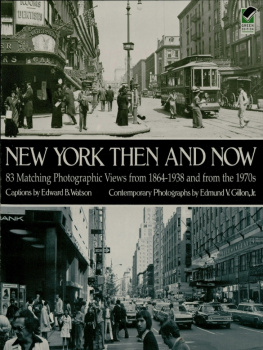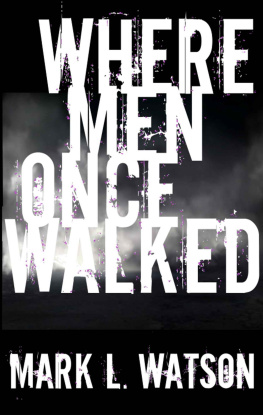At Dover Publications were committed to producing books in an earth-friendly manner and to helping our customers make greener choices. Manufacturing books in the United States ensures compliance with strict environmental laws and eliminates the need for international freight shipping, a major contributor to global air pollution. And printing on recycled paper helps minimize our consumption of trees, water and fossil fuels.
The text of this book was printed on paper made with 10% post-consumer waste and the cover was printed on paper made with 10% post-consumer waste. At Dover, we use Environmental Defenses Paper Calculator to measure the benefits of these choices, including: the number of trees saved, gallons of water conserved as well as air emissions and solid waste eliminated.
Please visit the product page for New York Then and Now at www.doverpublications.com to see a detailed account of the environmental savings weve achieved over the life of this book.
Copyright 1976 by Dover Publications, Inc.
All rights reserved
New York Then and Now is a new work, first
published by Dover Publications, Inc., in 1976.
Library of Congress Catalog Card Number: 76-3240
International Standard Book Number
9780486131061
Manufactured in the United States by Courier Corporation
23361817
www.doverpublications.com
PUBLISHERS NOTE
This book contrasts photographic views of New York taken between 1864 and 1938 with views of the same sites as they appeared in 1974-75. Forty-eight of the early photographs are taken from the extensive and diverse Seidman historical archive; 38 have been supplied from Mr. Watsons collection. There was considerable choice in selecting this material; since the first daguerreotype was taken of New York in 1839, it has been one of the most extensively photographed cities. The plates have been chosen to represent the major thoroughfares and districts of Manhattan. No attempt has been made to dramatize the degree and nature of change in the city or to make the book conform to any particular opinion about the implications of change.
In contrast to the more artistic (and famous) photographs of the city taken at the turn of the century by such photographers as Edward Steichen and Alfred Stieglitz, most of the pictures in this volume were taken by anonymous photographers for didactic purposes. In matching them, Mr. Gillon has adhered to a similar straightforward approach: his lighting is even and his prints are developed to maximize detail; he has not strived for artistic effect. He has made every effort to match the original vantage points as closely as possible but, in a few instances, physical alterations at a site have necessitated some shift of angle. In some scenes, such as the pair of views of Madison Avenue, looking south from East 31st Street (pp.92, 93), distances and proportions do not appear to correspond. This phenomenon is caused not by a change of vantage point, but by differences between the two photographers equipment.
It is curious that, although countless photographs of the city have been taken, there has never been any project to record, in a systematic and thorough manner, the appearance of the city at a given time. Even though Mr. Gillon has taken only 83 photographs, this book is a step in that direction. As a further aid, the date and time (always during daylight hours) at which each photograph was taken is recorded at the end of each caption for the modern photographs. (In many of the older photographs, this information can be established only on the basis of internal evidence.)
In keeping with the straightforward nature of the photographs, Mr. Watson has confined himself to fact in writing the captions. With little editorial comment, he notes trends and changes in architecture, transportation and other characteristics of the city. For the most part, the reader is left to form his own opinions about the development and changing nature of New York.
The photographs reveal many obvious changes to the browserthe passing of the horse and the subsequent proliferation of traffic, the development of high-rise buildings, and the evolution of womens fashions. Many less obvious changes are revealed only through study. One can observe shifts in ethnic and racial populations and changes in patterns of land use and development. During the last century, for example, it was inconceivable that a landowner would not build on a parcel in a developed section of the city, yet today parking lots and fallow properties are seen everywhere. It also becomes apparent that, while some aspects of the city have changed radically, exceeding the wildest imaginings of nineteenth-century writers, other aspects remain virtually the same. There is little to differentiate todays sidewalk food vendor from his counterpart of 1900.
Change is New Yorks identifying trait. Compared with other cities, its buildings have a very short life span. Stanford Whites Presbyterian Church, an outstanding piece of architecture, stood for only 13 years before it was razed. What will the city look like 100 years from now? One would like to think that another edition of this book will be published then, recording, from the same vantage points, the changes brought about by subsequent waves of demolition and construction.
NEW YORK THEN AND NOW
83 MATCHING PHOTOGRAPHIC VIEWS FROM 18641938 AND FROM THE 1970s
Broadway, North from State Street, Looking toward Bowling Green (1914)
Here is the beginning of Broadway, New Yorks greatest street. The edge of the Customs House (right) shows Daniel Chester Frenchs allegorical group Africa, one of the Four Continents group. The Washington Building is located on the left-hand corner; the Bowling Green Building is just beyond. Behind the only double-deck streetcar ever to run in New York City is the great canyon of lower Broadway. The steel construction with finished courses of white brick, visible at left center, is the Adams Express Building. Farther along on the west side of Broadway stands the tower of the Singer Building. In the distance is the recently completed Woolworth Building, then the worlds tallest structure.
Broadway, North from State Street, Looking toward Bowling Green (1974)
In late 1974, Bowling Green, New Yorks first public park, was being reconstructed to conform with the plan of 1786. The former Customs House, with the sculptured group Africa, stands unchanged and the Bowling Green Building remains at the extreme left. Beyond Bowling Green, on the east side of Broadway, is the huge No. 26 Broadway Building, originally built for the Standard Oil Co. in 1924. It took the place of the three office buildings on the site. Looking up Broadway, the former Adams Express Building (now American Express), with a dark cornice, still remains. The Singer Tower is gone, but in its place is the new United States Steel Building, the top of its black structure visible to the right of the American Express Building. In the center, the Woolworth Tower continues to dominate lower Broadway. (9/30/74; 3:15.)















![Watson - Under the hammer : Edward I and Scotland, 1286-1306 [sic]](/uploads/posts/book/103524/thumbs/watson-under-the-hammer-edward-i-and-scotland.jpg)

